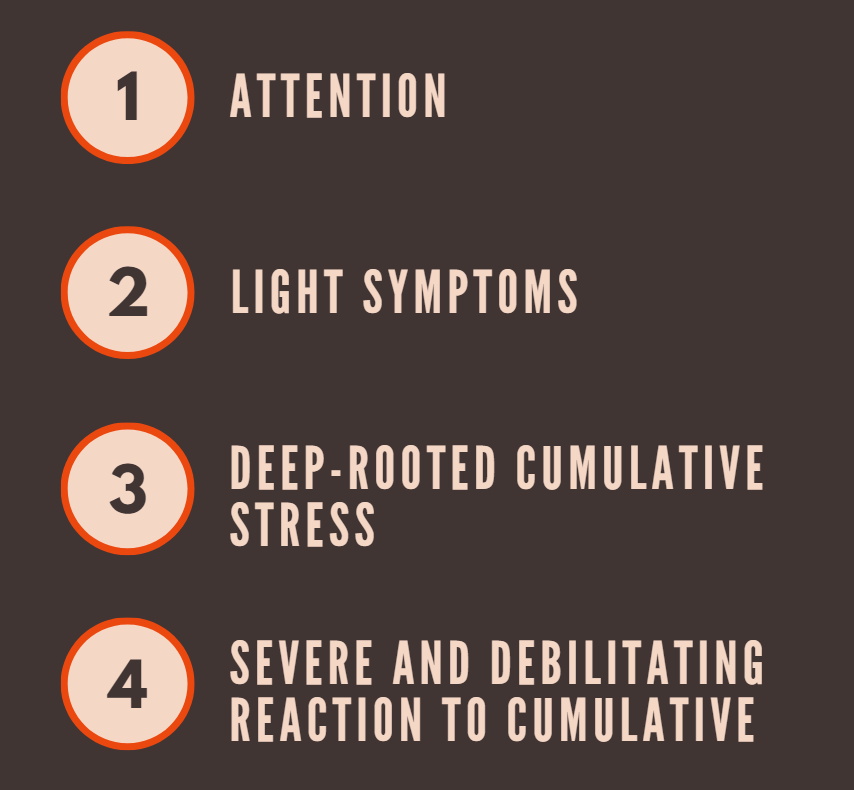It’s common to be under stress in the workplace. It is such an ordinary everyday fact, that at a multinational I worked for a few years ago, it was the top item on the occupational physician’s list when anybody came into the clinic in the middle of the day. “Are you under stress?”, she would ask. I remember that would always make us laugh among ourselves, after all, in our minds, the answer was obvious: “Yes, we’re always under stress!”. The only question was, “to what extent?” Our only doubt was about intensity.
And that is exactly the issue that needs one’s attention with regard to stress in the workplace: the intensity and our ability to deal with it. A little bit of stress can be positive for you to perform well at your job functions. It will keep you on your toes, energized and motivated. The secret to dealing with stress in the workplace is to identify the amount and the intensity from which it starts to harm your health and wellbeing, affecting your relationships, your performance and standard of living.
According to the American Psychological Association, a stressful work environment can contribute towards the following:
In the short term, you develop headaches, stomachache, irritability and difficulty to concentrate.
In the long run, it generates anxiety, insomnia, high blood pressure and a low immune system, leaving you more susceptible to diseases, such as: obesity, heart disease and even depression.
To make things even worse, if you are exposed to chronic high-level stress, there is a high probability that, in order to deal with stress in the workplace, you start to develop habits that are harmful to your health. Among them, the most common are: unhealthy food intake, such as sugar and refined carbohydrates, excessive smoking and drug and alcohol abuse.
Not a pretty picture, I think you’ll agree. Very sad too, for you and those who love you.
There are many factors that cause stress at work. Below is a list of a few of them, based on L. R. Murphy’s work in “Occupational Stress Management, current status and future directions”. Just by writing about these facts reminds me of many situations I’ve been through and it is impossible not to relive some bad feelings. But I think it’s all in a day’s work, as they say; we are, after all, exposed to many of these situations in our everyday working life. I imagine this also goes through your mind from time to time. Go easy, ok?
Factors related to the job itself: work overload, lack of independence, work shifts, lack of preparation to perform your functions, physical environment where you work, isolation.
Your function within the organization: level of responsibility (the higher it is, the worse it is), conflict of functions (when you have more than one boss), lack of clarity regarding your responsibilities.

Just fired (Photo: Naenaejung / iStock)
Career development: fear of being dismissed, career stagnation, quick, excessive promotion, lack of job satisfaction as a whole.
Your relationships at work: bad relationships with boss, peers, subordinates or clients, moral or sexual harassment, lack of trust in the people around you.
Atmosphere and organizational structure: no participation in the decision-making process, incompatibility with general management style within the company, bad or inexistent communication, lack of formal channels to speak through and deal with your problems within the organization, feeling of unfairness.
Balance between work and life outside the office: conflict of functions and responsibilities, family exposed to dangers as a result of your professional choice.
Finally, I think it’s also worth commenting that it is common for there to be more than one factor at hand, when your job demands a lot from you, for example, but at the same time you have little control over it. Situations such as these create a feeling of powerlessness, apathy and impotence. These factors, together, exacerbate the harmful effects of stress.
Based on the life experience of many people with whom I have been, myself included, generally speaking, stress in the workplace is not something that happens overnight, with a bang. It normally develops chronically over time. This means that if you’re not careful, things get worse as time goes by. It’s like a videogame. At each “stage” you go through, the game gets more difficult and the effects get more harmful with regard to your health and standard of living.
Different symptoms appear in each phase. If you are paying attention to them, they are possible to identify, and from that diagnosis, you can start to act in order to relieve your condition. The secret here is to make the diagnosis as early as possible and take action in order to deal with the stress causes, after all, it’s easier to act in the initial stages. If you do nothing and the stress factors, causes and context remain, the tendency will be for you to sink into an ever-growing hole, with extremely bad consequences for your health and relationships.
Out of everything I have researched, the material that seemed to me to be most useful to you is the article “The High Cost of Caring: Coping with Workplace Stress in Sharing”, by B.L. Anschuetz, Epilepsy Ontario. Published on 29/Nov/1999, it will help you to identify the phase in which you find yourself, which symptoms may be present and what you can do to reverse the situation. In the figure below, I have reproduced part of the article for your reflexion.

Stages of stress in the workplace
The first warning signs are often more emotional than physical and can take at least a year to be noticed.
Symptoms: vague feelings of anxiety, depression, boredom, apathy and emotional fatigue.
What to do: talk about your feelings with your family and friends, take a vacation, take physical exercise, eat correctly, do not jeopardize your sleep, make changes in your daily activities, better organize your time and dedicate more of it to yourself.
The warning signs have progressed and intensified. In a period ranging between 6 and 18 months, physical issues may become visible.
Symptoms: sleeping disorders, colds and more frequent headaches, muscular pain, intensified physical and emotional fatigue, social withdrawal, increased irritability and depression.
What to do: more aggressive changes in lifestyle will become necessary. If you don’t make them, the picture tends to get worse. Short term therapy is also recommended.

Man drinking (Photo: Sturti / iStock)
This phase occurs when the factors listed above continue to be ignored. Stress starts to have greater impact on career, family life and personal wellbeing.
Symptoms: increased use of alcohol, cigarettes, self-medication, depression, physical and emotional fatigue, reduced sex drive, ulcers, marital conflict, crying spells, increased anxiety, obstinate thoughts, withdrawal, restlessness and insomnia.
What to do: resolving the aforementioned phases will not be enough to reverse the picture in phase 3. The suggestion here is to seek medical and psychological help.
This phase is frequently considered “self-destructive” and tends to occur after 5 to 10 years of continuous stress.
Symptoms: premature interruption of career, asthma, heart problems, severe depression, declining self- esteem and self-confidence, inability to perform work-related tasks, inability to run personal life, withdrawal from the world, incontrollable rage, sadness, anger, suicidal or homicidal thoughts, muscular tremors, extreme chronic fatigue, exaggerated reaction to small events, agitation, frequent accidents, carelessness, forgetfulness and paranoia.
What to do: professional healthcare intervention (doctors and psychologists) is crucial and mandatory. Without this intervention, the situation cannot be reversed.
Finally, a quick word of caution to say that my intention when writing this article was just to throw some light on the subject and incite your reflexions on it, ideally still at the beginning of the process. If, on reading this article, you think you are under stress in the workplace, I recommend you see your doctor or therapist and follow their instructions. They will both be much more apt to provide you with help and follow-up, ok?
That is the correct course of action to take and I wish you lots of luck on the road to rebuilding your health, your relationships and your joie de vivre. You do not need, nor deserve, to lead a hard life.
Cover photo credit – Stressed woman at work (Photo: Gpointstudio / Unsplash)